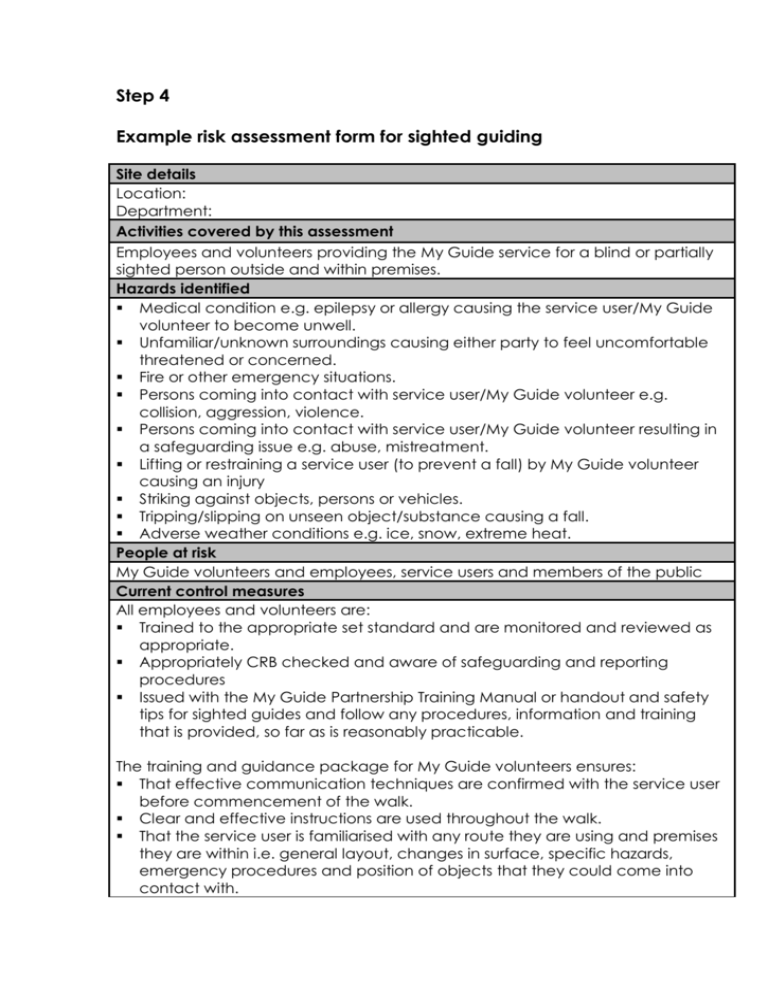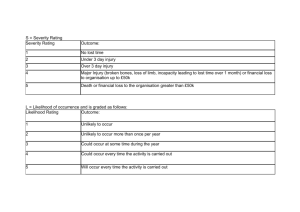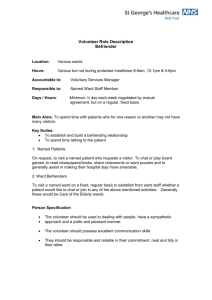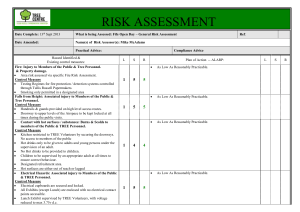Example risk assessment form for sighted guiding
advertisement

Step 4 Example risk assessment form for sighted guiding Site details Location: Department: Activities covered by this assessment Employees and volunteers providing the My Guide service for a blind or partially sighted person outside and within premises. Hazards identified Medical condition e.g. epilepsy or allergy causing the service user/My Guide volunteer to become unwell. Unfamiliar/unknown surroundings causing either party to feel uncomfortable threatened or concerned. Fire or other emergency situations. Persons coming into contact with service user/My Guide volunteer e.g. collision, aggression, violence. Persons coming into contact with service user/My Guide volunteer resulting in a safeguarding issue e.g. abuse, mistreatment. Lifting or restraining a service user (to prevent a fall) by My Guide volunteer causing an injury Striking against objects, persons or vehicles. Tripping/slipping on unseen object/substance causing a fall. Adverse weather conditions e.g. ice, snow, extreme heat. People at risk My Guide volunteers and employees, service users and members of the public Current control measures All employees and volunteers are: Trained to the appropriate set standard and are monitored and reviewed as appropriate. Appropriately CRB checked and aware of safeguarding and reporting procedures Issued with the My Guide Partnership Training Manual or handout and safety tips for sighted guides and follow any procedures, information and training that is provided, so far as is reasonably practicable. The training and guidance package for My Guide volunteers ensures: That effective communication techniques are confirmed with the service user before commencement of the walk. Clear and effective instructions are used throughout the walk. That the service user is familiarised with any route they are using and premises they are within i.e. general layout, changes in surface, specific hazards, emergency procedures and position of objects that they could come into contact with. Awareness of and adherence to correct travel position within each relevant area. That the volunteer will always go first as appropriate. That they will ask the service user to advise of any medical condition which may impact on the activity being undertaken and this information will be communicated as appropriate. That the service user advises of any medical condition they have which may impact on the activity being undertaken and this information will be communicated as appropriate. That they avoid as far as is reasonably practicable unknown persons coming into contact with the service user/My Guide volunteer. That they will familiarise themselves regarding what to do in the in the event of a fire, incident and other emergency situations as appropriate. They will avoid lifting or restraining a service user (to prevent a fall) when they can, so far as is reasonably practicable. That they avoid and are aware of the need to look out for objects, persons and vehicles. They will consider the weather conditions e.g. ice, snow, extreme heat, and how this could affect the trip. My Guide volunteers and employees are monitored and the training updated and reviewed at appropriate intervals. Evaluation of risk: (using risk rating table) Severity Likelihood Risk Rating = Low(1) Medium(2) Low(1) Medium(2) Severity x Likelihood High(3) High(3) High (3) Low (1) Medium (3) Further control measures or actions Action required Person responsible Completion Date due date complete Signature of person completing assessment: Date of assessment: Review date: Print name: Position: Review by: Residual risk rating: (following implementation of control measures) Severity Likelihood Risk Rating = Low(1) Medium(2) Low(1) Medium(2) Severity x Likelihood High(3) High(3) Signature of person re-evaluating: Date of re-evaluation: Review date: Print name: Position: Review by:





